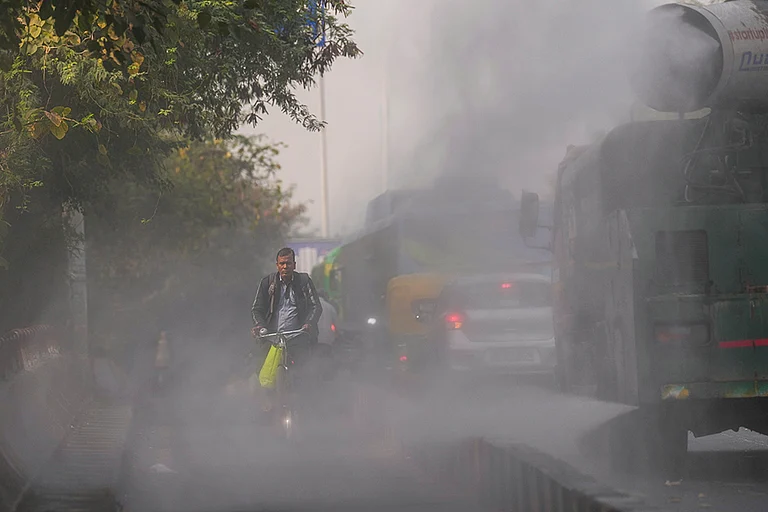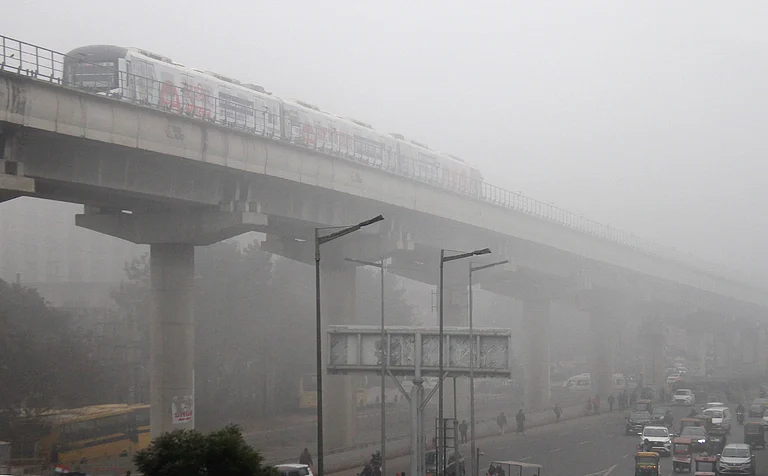
Delhi’s AQI stood at 291, the lowest for this date since 2019, amid intensified anti-pollution drives and mechanical road sweeping.
Over 7,500 challans were issued for vehicular pollution, and more than 1,200 enforcement teams patrolled the city to curb dust and open burning.
Despite official claims of improvement, IQAir reported “hazardous” AQI levels above 1,000 in some localities, while CPCB recorded a lower average of 351.
In the past 24 hours, Delhi has issued more than 7,500 challans for vehicular pollution, and 2,300 miles of roads have been mechanically swept, according to official data.
The Delhi government announced in a statement that Tuesday's Air Quality Index (AQI) was the best for this day in seven years, standing at 291, down from 381 in 2024, 415 in 2023, 447 in 2022, 382 in 2021, 343 in 2020, and 407 in 2019.
Reportedly, Delhi's air quality has improved over the past few years because to persistent and scientific interventions, it claimed, despite geographical obstacles, Parali burning in surrounding states, building activities, an increase in car registrations, and the "Green Diwali" celebrations.
The government supplied data showing that 2,300 km of road were mechanically swept and 219 inspections were conducted for unlawful disposal sites.
Compared to 6,058 on Sunday, 7,580 challans were issued for traffic pollution. 2,322.1 metric tonnes of garbage from construction and demolition were lifted.
341 complaints received via the app and social media were addressed and resolved, while 91 trucks that were not intended for Delhi were rerouted via the Eastern and Western Periphery. At the borders, up to 105 interstate buses were inspected and halted.
The year-on-year comparison data reflects our sustained and coordinated pollution control strategy, Sirsa said.
All agencies have received instructions from the Environment Department to step up their efforts to reduce dust in the city. This includes tight controls on open burning and construction dust, regular rubbish collection, improved misting and sprinkling operations, and automated road cleaning.
To avoid open burning occurrences, more than 1,200 enforcement teams patrol wards and industrial areas around-the-clock. These teams include 443 teams that oppose open waste burning, 378 teams that control dust, and 578 teams that control vehicular pollution.
“We are continuing large-scale deployment of 390 anti-smog guns, 280 water sprinklers, and 76 mechanical sweepers. Regular vehicular pollution checks are being conducted to control tailpipe emissions. All agencies are working in coordination to maintain this improving trend through the winter,” Sirsa said.
He emphasised that the Delhi government’s Winter Action Plan is not limited to enforcement but focuses on long-term behavioural change and cleaner infrastructure.
Alternate Reports
The Swiss air technology company IQAir reported on 21 October that the AQI in some areas of Delhi ranged from 800 to 1,100, which is considered "hazardous." The highest AQI readings were 1,105, 1,057, and 1,041 in Anand Vihar, Dwarka Sector 8, and Vasant Vihar (VV) Block C, respectively.
However, India's Central Pollution Control Board (CPCB) reported a much lower AQI of 351, falling under the "very poor" category.






.jpg?w=630&auto=format%2Ccompress&fit=max&format=webp&dpr=1.0)





















